The harm and prevention of common leaf beetles to garden plants
Notice

Common in gardens
The main leaf beetle pests are:
Willow blue leaf beetle
Ligustrum lucidum
Ligustrum lucidum leafminer
Green-haired leaf beetle
Coconut leaf beetle
Walnut leaf beetle
...........
1. Willow blue leaf beetle
(1) Key points for identification: It belongs to the order Coleoptera, family Chrysomelidae. It is nearly round, dark blue, and has a metallic luster.
(2) Occurrence pattern: There are 4 to 6 generations per year, and the adults overwinter in the soil, fallen leaves or weeds. They come out in April of the following year when the willows sprout. In mid-September, adults and larvae can be seen at the same time. The adults have a tendency to feign death.
(3) Distribution and harm: It mainly harms various willow trees . The adults and larvae feed on willow leaves, and in severe cases, all the leaves are eaten up. The adults feed on the leaves, leaving notches or holes. After the larvae gnaw on the leaf surface, they leave a layer of relatively transparent leaf tissue, which sometimes also causes notches or holes.
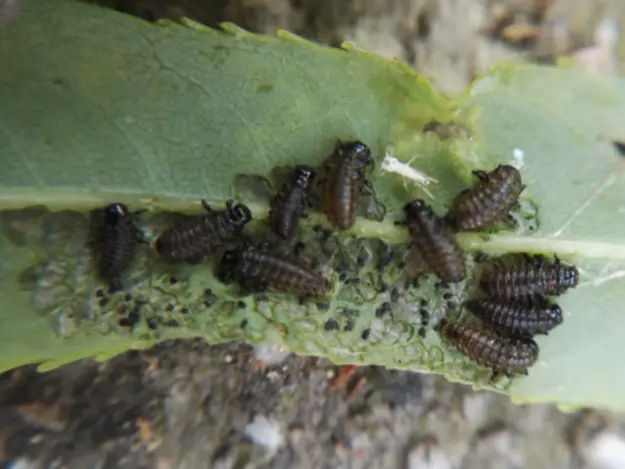
▲ Larvae of the willow blue leaf beetle
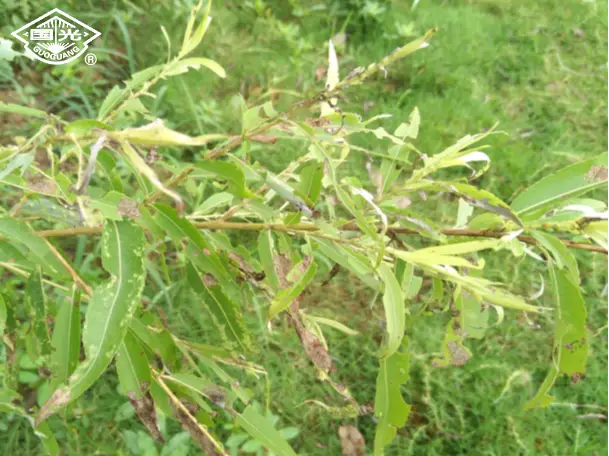
▲ Damage to willow leaves
2. Ligustrum lucidum flea beetle
(1) Identification points: Belongs to the family Chrysomelidae in the order Coleoptera. Oval or round, black, with a metallic luster on the back, and an oval red patch in the center of the wing elytra.
(2) Occurrence pattern: Adults emerge from hibernation in mid-to-late April of the following year. The peak periods of damage by the three generations of larvae are from mid-May to mid-June, late June to late July, and early August to early September, respectively.
(3) Distribution and damage: It mainly harms Oleaceae plants such as Ligustrum lucidum, Ligustrum lucidum, Ligustrum grandiflorum, Fraxinus chinensis, Fraxinus chinensis, Syringa syringae, and Osmanthus fragrans. The larvae feed on the leaves. The newly hatched larvae sneak into the leaves from the back and eat the mesophyll between the upper and lower epidermis. The insect tracks are brown and filamentous. The insect tracks of 2nd to 3rd instar larvae are significantly widened and the feeding amount is significantly increased, so that the leaves are densely covered with curved snake-like insect tracks. The adults eat the mesophyll on the back of the leaves, forming many irregular round or long transparent spots or holes on the leaves, and sometimes cause leaf spot disease.
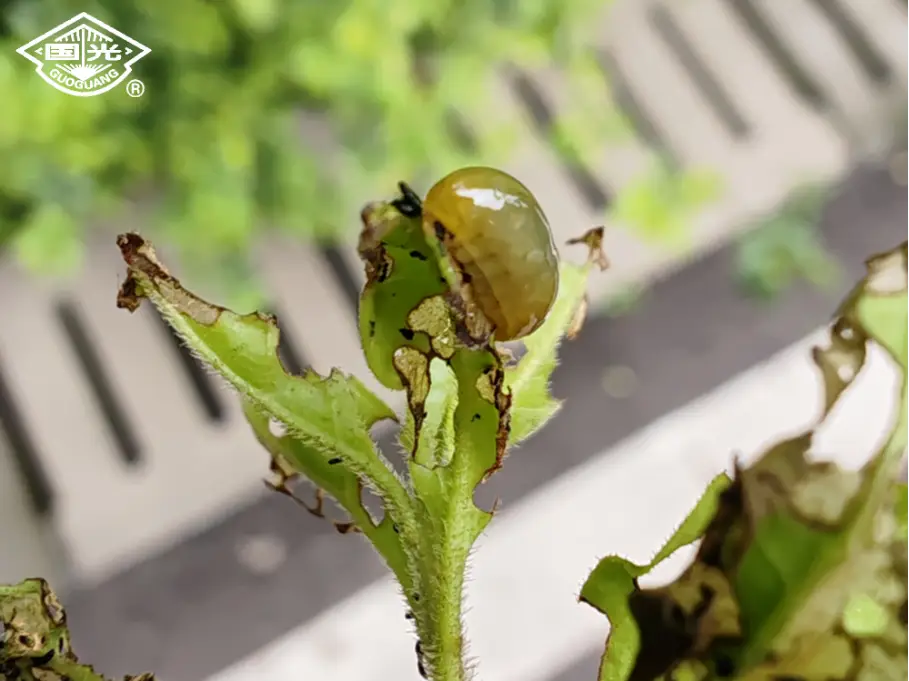
▲ Larvae of Ligustrum lucidum flea beetle
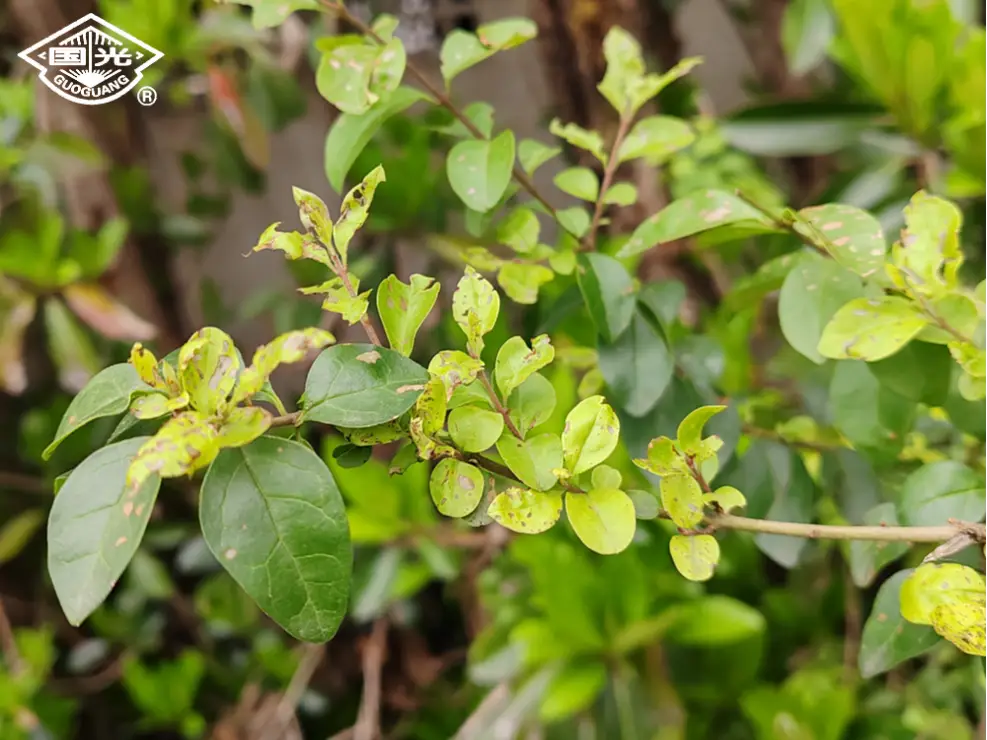
▲ Damage caused to new leaves of Ligustrum lucidum
3. Ligustrum lucidum leaf flea beetle
(1) Occurrence pattern: Generally, there are three generations a year. The mature larvae overwinter in the soil. Adults emerge in late April of the following year. There is one generation from May to mid-June, one generation from late June to late July, and the third generation of larvae emerges from late August to September.
(2) Distribution and harm: It mainly harms the leaves of Ligustrum lucidum . The adult insects feed on the leaves, causing small round or irregular spots to appear on the leaves. The larvae burrow under the skin and drill curved tunnels under the epidermis, destroying the chloroplast structure and weakening photosynthesis. It causes a large number of leaves to wither and burn, affecting the green landscaping effect.
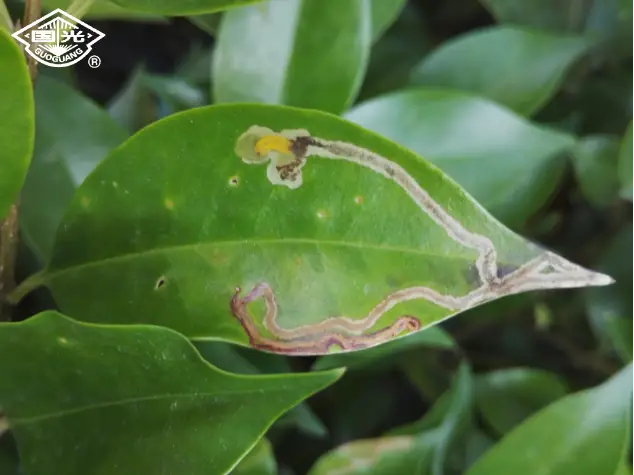
▲ Damage caused by Ligustrum lucidum flea beetle
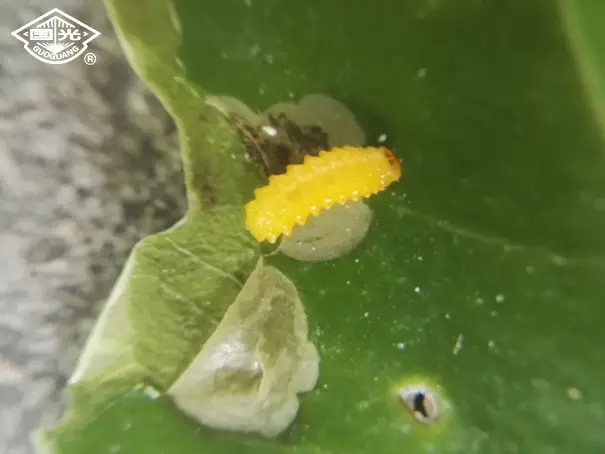
▲ Morphological characteristics of larvae
4. Elm green firefly leaf beetle
(1) Key points for identification: Belongs to the order Coleoptera, family Chrysomelidae. The adult is oblong, with a yellowish-brown body and blue-green elytra with a metallic luster. The head is small with a blunt triangular black stripe on the top of the head.
(2) Occurrence pattern: In Northeast China, North China, and Henan, there are 2-3 generations per year. The adults overwinter in rocks, dead branches and leaves, and in the cracks of buildings. In late March to early April of the following year, the overwintering adults begin to climb trees and cause damage. The first generation of larvae begins to appear in late April or early May, and the first generation of adults appears in early or mid-June.
(3) Distribution and damage: The green leaf beetle is a major pest on elm trees and is very common in North China. Adults and larvae cause holes in the leaves. In severe cases, the entire tree crown will turn yellow or even eat all the leaves, leaving only the veins, seriously affecting the normal growth of the plant.
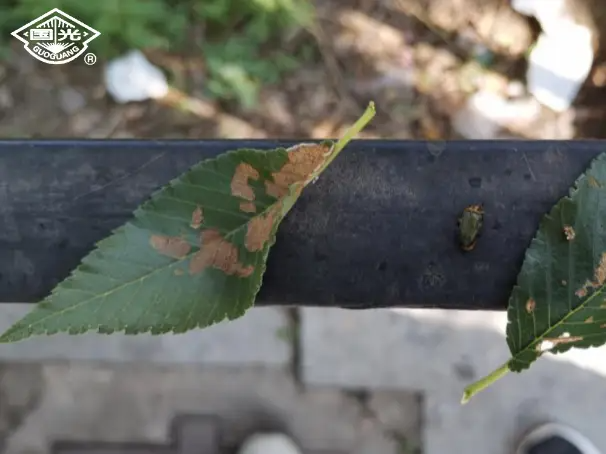
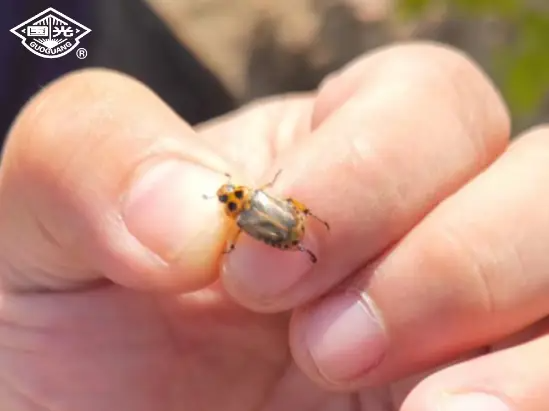
▲ Adults and damage of the green-haired elm leaf beetle
5. Walnut leaf beetle
(1) Key points for identification: Belongs to the order Coleoptera, family Chrysomelidae. Rectangular in shape, with a flat back. The pronotum is light brownish yellow, the elytra are blue-black, and the antennae and legs are all black.
(2) Occurrence pattern: One generation occurs per year, and the adults hibernate in the dead branches and leaves and in the cracks of the bark. The hibernating adults begin to move in late April of the following year, and begin to lay eggs in early May. The larvae hatch in mid-May, and the mature larvae pupate in early June. The new generation of adults emerges in mid-June, and the adults begin to hibernate in mid-October.
(3) Distribution and damage: Distributed in Gansu, Jiangsu, Hubei, Hunan, Guangxi, Sichuan, Guizhou, Shaanxi, Henan, Zhejiang, Fujian, Guangdong, Heilongjiang, Jilin, Liaoning, Hebei, etc. It mainly harms the leaves of walnut plants , and the phenomenon of leaves being eaten up often occurs. When it harms for many years, it causes the death of some branches or young trees.
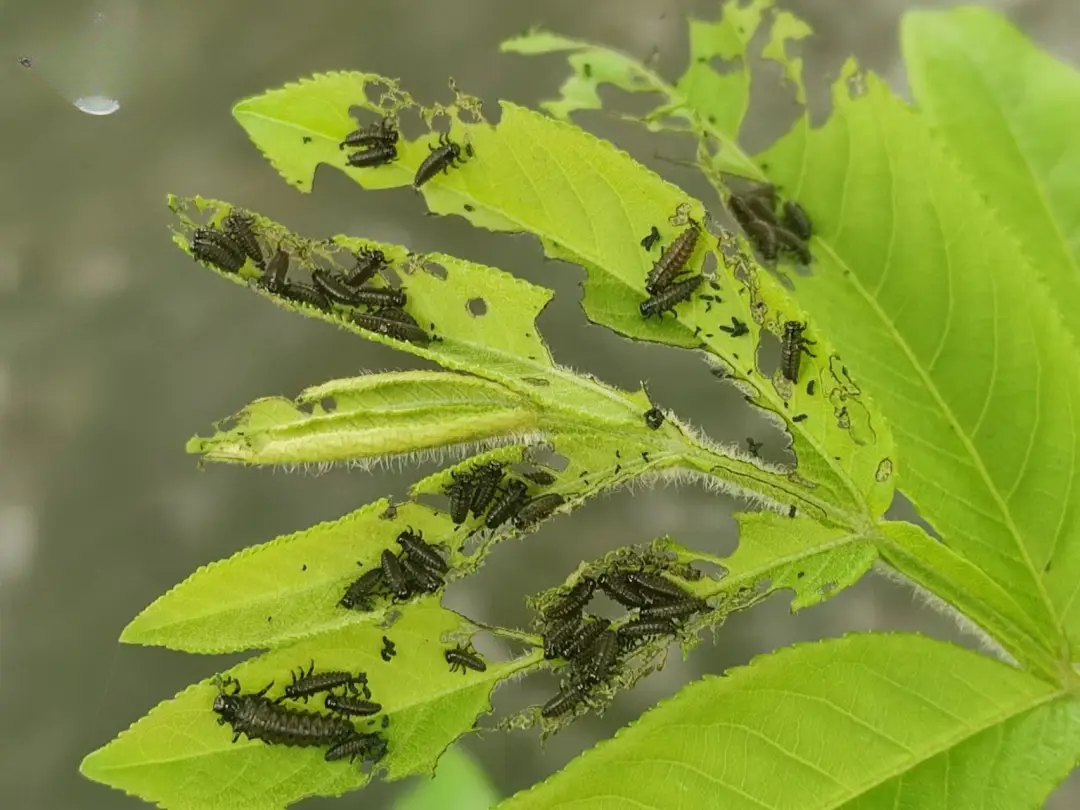
▲ Walnut leaf beetle
6. Coconut Heart Leaf Beetle
(1) Key points for identification: Coconut heart leaf beetle belongs to the order Coleoptera, superfamily Chrysomelidae. It is a major dangerous alien pest and is a Class II international plant quarantine object prohibited from entering the country. It harms palm plants, mainly coconuts. It ranks third in the list of 21 forestry quarantine pests published by the State Forestry and Grassland Administration.
(2) Occurrence pattern: Coconut heart leaf beetles have 3 to 6 generations per year, with overlapping generations. It takes about 52 days to complete one generation. The number of generations and the speed of development vary from place to place. Adults choose to lay eggs at the base of the heart leaf, either individually or in short longitudinal rows. The eggs are attached to the edge of the leaf with one end, and there are usually adult excrement and plant residues around the eggs. It takes about 12 days for adults to mature after emerging from their shells. Each female lays more than 100 eggs and has a lifespan of 2-3 months.
(3) Distribution and harm: They lurk at the base of petioles or other dark places during the day and are active at night. They mainly infest the young heart leaves of coconut trees and other economic plants of the palm family in two stages: adults and larvae . They only feed on the heart leaves that have not yet opened or hide in the interlayer of the heart leaves to gnaw, causing the death of mesophyll cells and leaving narrow brown stripes parallel to the veins on the leaf surface. These stripes form narrow scars. In severe cases, the leaves curl and shrink as if burned. When the leaves are severely damaged, they may show signs of withering, breaking, breaking branches, or only leaving the veins. Sometimes, several leaves on the top are scorched and the tree will soon decline and die.
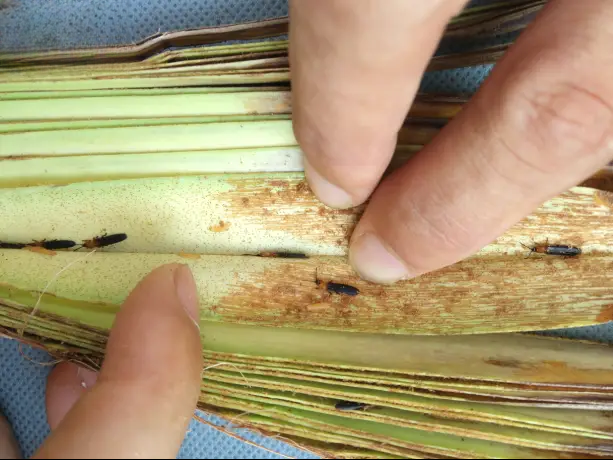
▲ Adults and larvae of the coconut palm leaf beetle
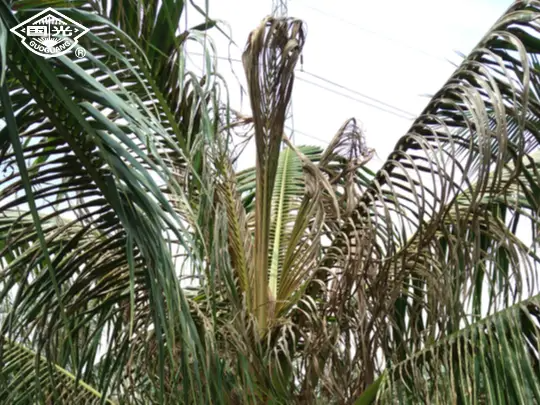
▲ The harm caused by the coconut leaf beetle

Leaf beetle control methods

01

Prevention methods for coconut palm leaf beetle
"Jia Ke" medicine bags can be used for hanging. 1-3 bags can be hung on each tree, mainly hung on the side of the heart leaves of palm plants. The medicine liquid is attached to the leaves by rain or artificial spraying, which plays a good preventive role and also has a good therapeutic effect.
02

Conventional foliar spray control of leaf beetles
You can use 1000 times of Ital , 1000 times of Jiake , 1000 times of Like , 2000 times of Leke , etc. for spraying for prevention and control.
Photo and text provided by Guoguang Garden Nursery Institute
Editing and typesetting丨Guoguang New Media Room